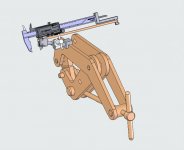What is the best way to cut a 3” hole in 2 1/2” plate?
I’m in a pretty basic millwright shop, no CNC Mill or I would have just circular interpolated the hole with a indeaxble end mill and finished it with a boring head (this hole is for a bearing pocket)
Having only a big old knee mill ( odd controls and no quill) and no drills over 1 1/2” Im stumped.
Torch cutting a messy hole well undersized then trying to clean up with a boring head??
The material is mild steel,
I’m in a pretty basic millwright shop, no CNC Mill or I would have just circular interpolated the hole with a indeaxble end mill and finished it with a boring head (this hole is for a bearing pocket)
Having only a big old knee mill ( odd controls and no quill) and no drills over 1 1/2” Im stumped.
Torch cutting a messy hole well undersized then trying to clean up with a boring head??
The material is mild steel,




